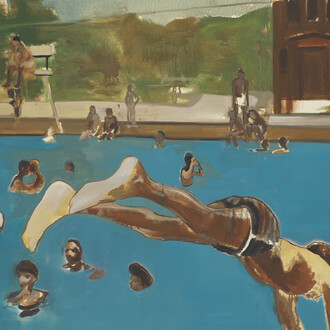Contaminated rhythms is the third solo exhibition of Promotesh Das Pulak (b. 1980, Bangladesh) in New York. This timely and visually arresting exhibition brings together a selection of kinetic sculptures and mixed-media installations that reflect Pulak’s deeply researched and emotionally charged engagement with ecology, militarism, and memory in South Asia.
Contaminated rhythms emerges as a critical meditation on the transformation of rivers—once revered as sacred sources of life—into vessels of pollution and environmental decay. Drawing on the artist’s own experiences growing up near the banks of the once-pristine rivers of Bangladesh, Pulak offers a poignant visual narrative that foregrounds the ecological crisis as both a material and spiritual rupture. His kinetic works physically move and shift, mimicking the fluidity of water, yet their compositions are often laden with signs of contamination: rusted metal, synthetic detritus, and broken mechanical forms entangled with organic matter such as dried shola flowers. These juxtapositions highlight the increasing entanglement of the natural and the industrial, of beauty and degradation, of life and entropy.
Beyond ecological concerns, Pulak’s practice explores the aesthetics of violence—how instruments of war are visually, culturally, and politically encoded. In a series of sculptural assemblages, he reconfigures objects such as AK-47s, gas masks, and combat gear into ornate, delicate constructions adorned with intricate floral motifs, hand-crafted embellishments, and ceremonial patterns. These contradictions compel viewers to reconcile the inherent dissonance between visual beauty and latent brutality. Pulak’s approach does not merely critique the use of violence but interrogates how society aestheticizes and normalizes it—turning tools of destruction into symbols of power, even pride.
The exhibition also reflects Pulak’s broader inquiry into the legacy of colonial militarism and the ways in which postcolonial nations continue to grapple with inherited and homegrown forms of violence. Through his transformation of war artifacts into decorative forms, Pulak challenges viewers to consider how historical trauma is beautified, obscured, or ritualized, and how this impacts our collective consciousness.
In it’s curatorial frame, Contaminated rhythms serves as both an elegy and a warning—a lament for the ecological and spiritual losses we have already incurred, and a cautionary vision of what lies ahead should the contamination of our natural and ethical environments continue unchecked. Pulak’s work resonates globally, speaking to urgent issues of environmental collapse, militarization, and cultural erasure, while remaining grounded in a local context that is specific to Bangladesh yet hauntingly familiar elsewhere.







